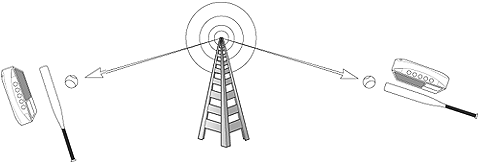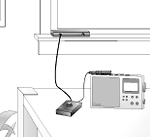Starting with these two simple principles, you can go a long way toward improving your AM reception without having to spend a lot of money or time.
Let's take a look at the first truth of AM reception - a good antenna. Outside of a few select radios engineered with AM radio listeners in mind (such as the CCRadio 2E, the CCRadio-SW, and the CCradio-EP PRO), most radios treat AM reception like an afterthought. Many radio manufacturers have relegated AM radio to the past, to the days before FM, and they aren't fully aware of AM's continued popularity across the country. The consequence of this move away from AM is that many radios just don't have very good AM antennas built into them. That means it's up to you to find a suitable AM antenna. More on this in a moment, first let's look at basic idea of number 2.
If you're trying to listen to a radio station that doesn't broadcast in your direction, chances are very slim that you'll have much luck. Also, if your antenna isn't correctly directed at the signal coming your way, you'll also experience diminished reception. Ideally, your antenna should be at right angles to the AM signals coming toward it. Think of it in terms of trying to hit a baseball with a bat. Even if you are a phenomenal hitter, it is difficult to hit a pitch with the narrow tip of the bat. Sure, you might come close. If you're lucky, you might even make contact with the ball, but you'll never make the good solid connection needed to hit a home run or even get a base hit. The same is true with radio signals that aren't hitting your antenna.

Now for the finer points. Choosing the right AM Antenna requires you get to know a bit about your specific needs. What type of home do you live in? Wood-frame buildings with wood siding shouldn't cause much of a problem. However, brick, cement block, stucco, aluminum, or metal-sided buildings almost always cause AM reception problems (unless, of course, you have a lot of windows which do not usually block AM radio waves). These types of building materials block and prevent a majority of AM radio waves from reaching your radio. The best way to find out if your building is the source of poor AM reception problem is to take a portable (battery operated) AM radio outside. If your reception improves, you've found your problem.
Now before you even consider tearing your home down to rebuild it with wood, we have a better solution. The Twin Coil Ferrite® AM Antenna has a receiver element that picks up the clean, clear signal from outside your home, then passes this strong signal through your building (via a coax cable) to a tuner box which then amplifies the signal before sending it to your radio. The amplification ensures your radio's receiver is delivered a good strong signal. The outdoor antenna element is small (size: 8.5" W x 2.5" H x 1.3") and easy to conceal somewhere outside, but we realize that some folks don't like the idea of having an antenna conflict with their home's landscaping or "curb appeal". An alternative is to put the antenna element in a window where the AM signal gets through and can then send this signal to the radio.


After reading this short piece does it seem like the Twin Coil Ferrite AM Antenna was designed specifically to address the two basics of AM radio reception? It should! At C. Crane we're proud to say that our Twin Coil Antenna reduces night time AM fade out by up to 99%. This means many more hours of clear radio listening over what you'd get with an ordinary radio or radio antenna. Just remember though, even with a good antenna like ours, the second basic idea still holds true - if the antenna isn't in-line with the signal, you'll never get the best reception.
As always, please contact us with any comments or article suggestions you might have.
